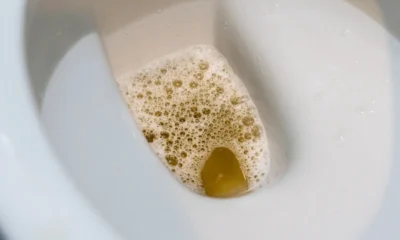Health
What Your Urine Colour Says About Your Health
Every drop of urine tells a story your body wants you to hear. From bright yellow to cloudy brown, your urine’s colour can reveal signs of dehydration, diet imbalance…

Every drop of urine tells a story your body wants you to hear. From bright yellow to cloudy brown, your urine’s colour can reveal signs of dehydration, diet imbalance, or even serious organ problems long before symptoms appear. Learn what your pee is saying about your health — and when to pay attention.
The colour of your urine isn’t just random
Most people don’t pay attention when they urinate — we flush and move on. But your urine colour is a simple, daily health check your body gives you for free. According to Mayo Clinic, the normal range of urine colour runs from pale straw-yellow to deep amber. Anything outside that range may be your body’s way of waving a flag.
Your kidneys act like natural filters, removing waste and balancing the water, salts, and minerals in your blood. When this balance shifts — whether because you’re dehydrated, taking medication, or have an underlying condition — it often reflects instantly in the colour of your urine.
What each colour could mean
Below are the most common urine colours and what they might indicate about your body:
Pale Yellow — You’re hydrated and healthy
This is the ideal shade. It means your kidneys are filtering properly, and your body has enough water to function efficiently. According to Cleveland Clinic, pale-yellow urine is a good sign that your hydration levels are balanced.

Dark Yellow or Amber — Dehydration alert
If your urine looks dark yellow or amber, it’s your body pleading for more water. It might also occur after sweating excessively (common under Nigeria’s hot weather), or when you’ve skipped meals and fluids all day. Dark urine can also come from too much vitamin B-complex or from eating foods like palm oil or carrots.
Brown — Possible liver or kidney problem
When your urine turns tea-coloured or brown, it may be linked to bile issues or liver conditions such as hepatitis. Healthline notes that persistent brown urine, especially with fatigue or yellowing of the eyes, should not be ignored.
Red or Pink — Blood may be present
Sometimes, reddish urine comes from eating beetroot or berries — that’s harmless. But if you haven’t eaten those and notice a reddish or pink tint, you might be seeing blood in your urine (haematuria). This could point to kidney stones, urinary tract infection (UTI), or even bladder problems. See a doctor immediately.
DON’T MISS: Sex, STDs and Silence: The Hidden Shame of Sexual Health in Nigeria
Blue or Green — Medication effect or rare infection
Certain antibiotics, dyes, or food colourings can turn urine blue or green. In very rare cases, it’s linked to bacterial infection. If it continues after you stop medication, get it checked.
Cloudy or Foamy — Protein in urine
Persistent foaminess could mean protein leakage, which may be an early sign of kidney disease. If your urine remains cloudy even after hydration, consult a healthcare provider.

Why You should pay more attention
In Nigeria’s hot climate, dehydration is a silent epidemic. Many people drink soft drinks or alcohol instead of water, which worsens dehydration and kidney stress. Meanwhile, late detection of kidney or liver disease is common because people ignore simple signs like urine changes.
Checking your urine colour daily — especially first thing in the morning — can save you from severe health complications later. It costs nothing, but gives insight money can’t easily buy.
How to keep your urine healthy
- Drink enough clean water daily — at least 2–3 litres, more if you’re outdoors or sweating.
- Reduce alcohol and caffeine, as they make you urinate more and dry you out faster.
- Eat hydrating foods like cucumber, watermelon, and oranges.
- Avoid holding your urine for too long — it stresses your bladder and kidneys.
- Observe changes in colour, smell, or frequency and consult a doctor if they persist.
- Get routine medical checks, especially kidney and liver tests once or twice a year.
Your urine is one of the most honest messengers your body has. When it changes colour, it’s speaking — sometimes softly, sometimes urgently. Don’t ignore it. A quick glance before you flush could be the early warning that saves your health.





















